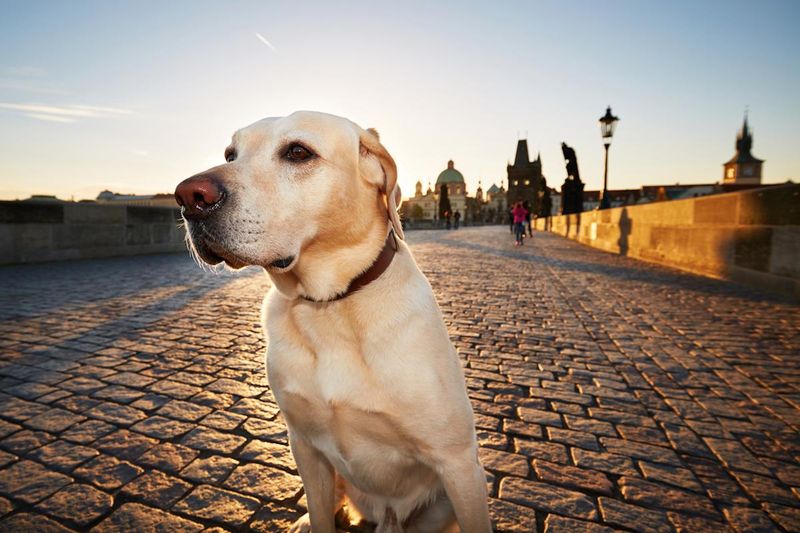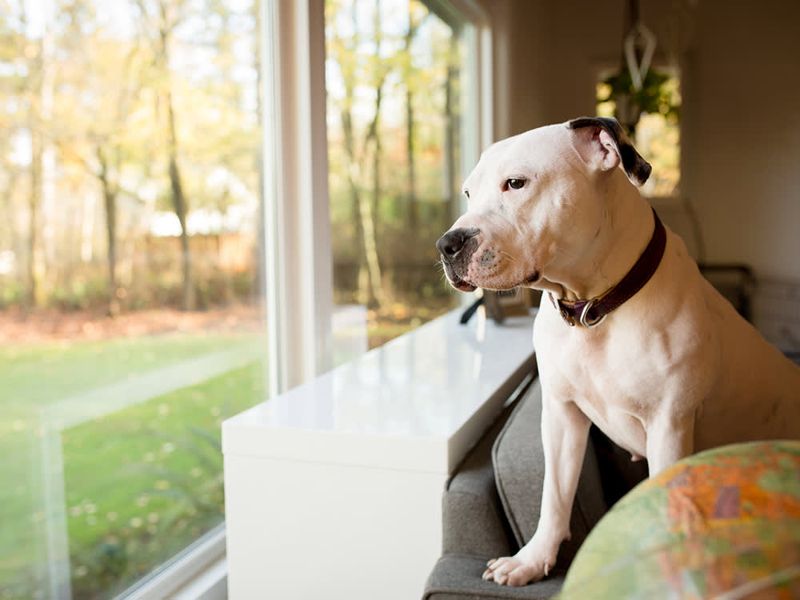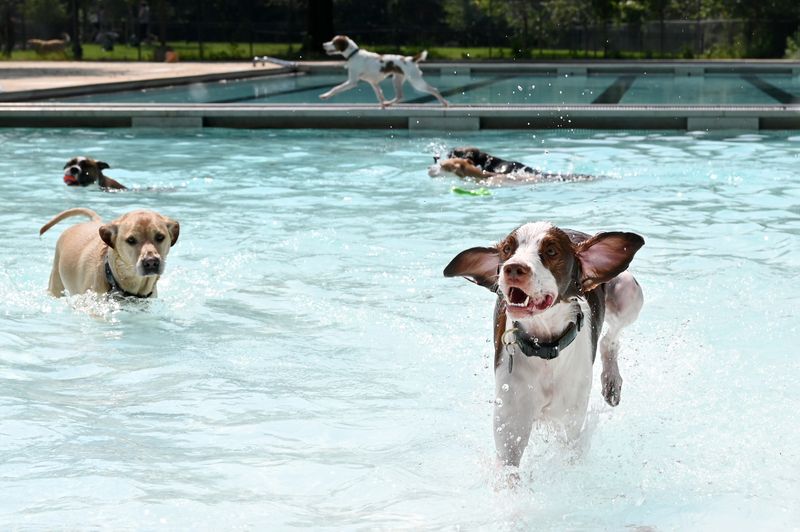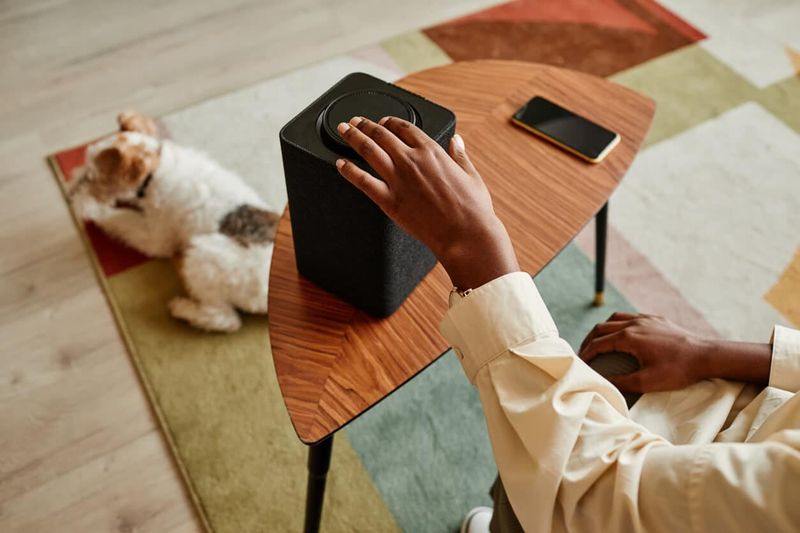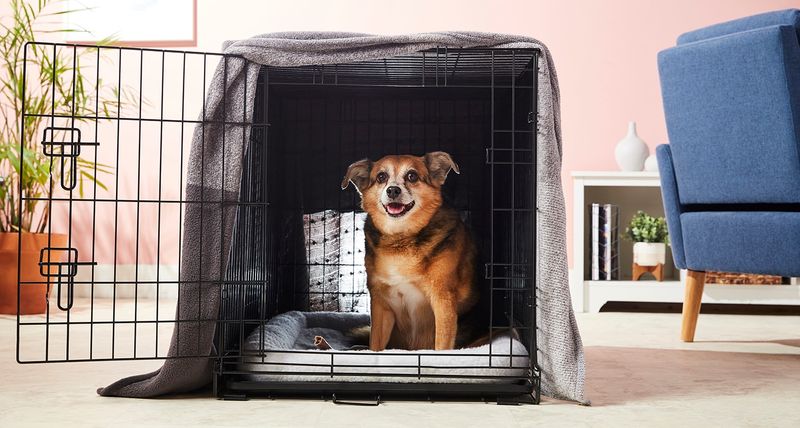Dogs are social animals, often suffering from stress when left alone. Understanding the triggers and implementing calming strategies can greatly enhance their well-being. This blog delves into 12 specific triggers that stress dogs when alone, alongside 12 effective ways to keep them calm. By exploring each item in detail, we aim to provide valuable insights for enhancing your dog’s comfort and happiness.
Loud Noises
Loud noises like fireworks or thunderstorms can terrify dogs. Imagine a sudden crack of thunder on a stormy night, shaking your walls. For a dog, with their acute hearing, it’s even more intense. This unexpected assault of sound can trigger panic and anxiety.
A fact to remember is that dogs’ ears are far more sensitive than ours, picking up frequencies we hardly notice. It’s no wonder that these cacophonous events lead to such distress.
During such times, a dog’s stress levels can spike, leading to destructive behavior or even attempts to escape to safety.
Being Confined
Confinement can be distressing for dogs, akin to a claustrophobic nightmare. Picture yourself trapped in a tiny room, with nowhere to go. Dogs, like humans, need freedom to roam and explore.
When confined, particularly in crates or small areas, their stress levels can rise significantly. This can manifest as whining, barking, or even attempts to break free.
Interestingly, dogs in the wild have vast territories, so restricting them goes against their natural instincts, leading to heightened anxiety.
Lack of Exercise
Exercise is crucial for a dog’s mental health. Without it, imagine a child stuck indoors with no chance to play—frustration builds. Dogs with pent-up energy often feel stress when they can’t release it.
A fun fact: Dogs that exercise regularly tend to have fewer behavioral issues, highlighting how vital it is for their well-being.
When they lack physical activity, it often leads to restlessness, anxiety, and even obesity, impacting their overall happiness and health.
Inconsistent Routine
Dogs thrive on routine, much like children who prefer a predictable bedtime story. A sudden change in schedule can unsettle them. Consider how you feel when your routine is disrupted; dogs experience similar confusion and stress.
A quirky insight: Dogs have an internal clock, often knowing when it’s feeding time or walk time.
Disruptions in daily patterns can leave them feeling insecure, leading to anxiety and behavioral problems, as they struggle to adapt to the shifting expectations.
Lack of Social Interaction
Dogs are inherently social creatures, akin to extroverts who crave interaction. Isolation can lead to emotional distress. Imagine not speaking to anyone for days—loneliness creeps in.
Dogs deprived of social interaction often show signs of depression and anxiety. A charming tidbit: Dogs have been known to form friendships with other dogs they frequently meet.
Without social engagement, they miss out on mental stimulation, which is essential for their well-being, leading to boredom and stress.
Separation Anxiety
Separation anxiety is a common issue, akin to a child clinging to a parent on the first day of school. Dogs, too, get attached to their humans. When left alone, their anxiety manifests as barking, destructive behavior, or going to the bathroom indoors.
An intriguing fact: Certain breeds are more prone to separation anxiety due to their loyal nature.
This attachment makes it challenging for them to cope when their owner is away, leading to significant stress that requires careful management.
Sudden Changes in Environment
Dogs are creatures of habit, and sudden environmental changes can be unsettling. Think of how you would feel moving to a new city without notice.
Dogs experience similar stress and confusion when placed in new settings. Their familiar smells and sights vanish, replaced by unknown elements.
A notable fact is that dogs rely heavily on scent; new environments disrupt their scent-based understanding of their territory, contributing to their anxiety.
Illness or Pain
Imagine enduring pain silently—it’s a reality for many dogs. Illness or injury can be a significant stress trigger, as they cannot communicate their discomfort.
An interesting insight is that dogs often hide pain as an evolutionary trait to avoid appearing weak.
This silent suffering can lead to behavioral changes, as their stress manifests through withdrawal, aggression, or lethargy. It’s crucial to monitor and respond to these signals promptly to alleviate their stress.
Lack of Mental Stimulation
Mental stimulation is as vital for dogs as it is for people. Imagine a mind left idle; boredom and anxiety soon follow. Dogs require activities that challenge their intellect.
A curious fact: Puzzles and interactive toys can significantly reduce stress in dogs.
Without such stimulation, they may develop destructive habits or become withdrawn, as their need for mental engagement remains unmet, leading to frustration and stress.
Unfamiliar People or Animals
Encountering unfamiliar faces can be daunting for dogs, akin to meeting strangers at a crowded party. This can trigger a defensive or anxious response.
A unique fact: Dogs often gauge unfamiliar people or animals through scent before deciding if they pose a threat.
Such encounters can cause stress, especially if they’re frequent or aggressive, leaving the dog on edge and unsure of their surroundings.
Changes in Family Dynamics
Family changes, like welcoming a new baby, can disrupt a dog’s sense of stability. Picture the upheaval of dynamics when a family expands. Dogs, like humans, need time to adjust.
An interesting tidbit: Dogs can often sense pregnancy due to hormonal changes in their owners.
These shifts can lead to stress as they navigate the new pecking order, requiring patience and assurance to feel secure once more.
Lack of Training
Training provides structure and understanding for dogs. Without it, they might feel like students without instructions, leading to stress and confusion.
A fascinating insight: Well-trained dogs tend to be more relaxed and confident.
Lack of guidance can lead to anxiety, as they misunderstand boundaries and expectations, resulting in behavioral issues that reflect their inner turmoil.
Calm Environment
Creating a calm environment can work wonders for an anxious dog. Picture a spa with gentle music and aromatic candles—tranquility at its best. Dogs, too, respond positively to such settings.
A soothing fact: Lavender is known to have calming effects on dogs.
By reducing noise, using calming scents, and maintaining a peaceful space, you can significantly lower a dog’s stress, helping them relax and feel secure.
Regular Exercise
Regular exercise is a fantastic stress-buster for dogs. Imagine the exhilaration of a good run, the wind rushing past. Dogs need this outlet to remain balanced and happy.
A motivating tidbit: Active dogs are generally healthier and more content, with fewer anxiety issues.
Ensuring they have daily opportunities to move and play can alleviate stress, keeping their minds and bodies engaged and satisfied.
Consistent Routine
Establishing a consistent routine offers comfort to dogs. Think of it as a daily rhythm that they can rely on. Predictability reduces anxiety and builds trust.
A reassuring insight: Dogs often thrive when they know what to expect each day.
By maintaining set meal times and walks, you create stability, helping them feel secure and less stressed.
Social Interaction
Social interaction is vital for a dog’s mental health. Consider it a lively conversation that brightens someone’s day. Dogs flourish in the company of others.
A joyful fact: Dogs often form bonds with their regular playmates, enhancing their social well-being.
Engaging them with other dogs or humans provides essential mental stimulation and happiness, reducing stress and fostering a sense of belonging.
Behavioral Training
Behavioral training helps dogs understand expectations, offering clarity and reducing anxiety. Think of it as a map guiding them through interactions.
An enlightening fact: Trained dogs often exhibit lower stress levels due to predictable outcomes.
Teaching them commands and boundaries can alleviate confusion, foster confidence, and maintain calmness.
Comforting Items
Comforting items like a soft blanket or beloved toy can ease a dog’s anxiety. Imagine a child clutching their favorite teddy bear for reassurance.
A heartwarming tidbit: Dogs often associate these items with safety and love.
Providing them with these objects can help reduce stress, offering a sense of security and familiarity in challenging situations.
Desensitization Techniques
Desensitization involves gradually acclimating dogs to stressors. Picture a gradual introduction to loud noises, reducing their impact over time.
An intriguing fact: Many dogs can overcome phobias through slow, positive exposure.
This technique helps them build resilience, decreasing anxiety and fostering calmness when faced with triggers.
Medication
In some cases, medication may be necessary to manage a dog’s anxiety. Think of it as a supportive tool, akin to a nightlight in the dark.
A responsible insight: Always consult a veterinarian before considering medication for anxiety.
When used appropriately, it can help stabilize their emotions, reducing stress and enabling them to cope better.
Soothing Music
Soothing music can have a calming effect on dogs, much like a gentle lullaby. Consider how a soft melody can ease your mind. Dogs, too, find solace in such sounds.
A delightful discovery: Classical music is particularly effective in reducing canine stress.
Playing calming tunes can help them unwind and feel more secure, turning chaos into calm.
Proper Nutrition
Proper nutrition plays a crucial role in a dog’s well-being. Imagine fueling your body with wholesome foods, feeling energized and balanced.
A nourishing tidbit: Omega-3 fatty acids can support a dog’s brain health, reducing anxiety.
Providing a balanced diet helps stabilize their mood, promoting calmness and reducing stress, ensuring they remain healthy and happy.
Massage and Touch Therapy
Massage and touch therapy can be incredibly soothing for dogs. Think of it as a comforting embrace that melts away tension.
A relaxing fact: Many dogs enjoy massages, benefiting from improved circulation and relaxation.
This tactile connection can help alleviate stress, fostering a sense of well-being and deep relaxation.
Safe Space
Creating a safe space allows dogs to retreat and relax. Imagine a personal sanctuary where worries melt away. Dogs need such havens to escape stressors.
A thoughtful insight: Dogs often gravitate towards spaces they associate with safety.
Ensuring they have access to a comforting nook can help them manage anxiety, offering refuge and a sense of peace.




